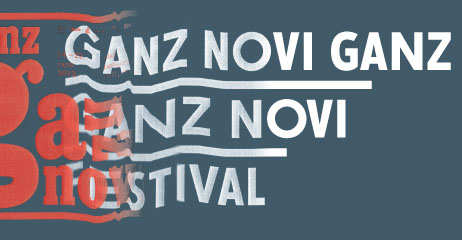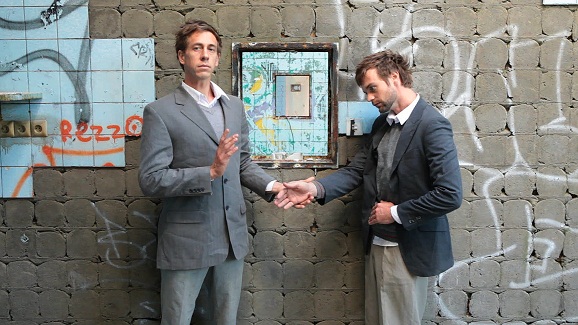FLORENT HAMON / BORIS GIBÉ, biography / interview
BORIS GIBÉ (FR)
Immersed from a young age into the circus world and homelessness, Boris gets his first professional experience at the age of twelve. In 1996, as co-founder of the company Zampanos, he participated in four creations that toured the villages in France but also 14 African countries in 2003. Since then he has confirmed his choice of nomadic lifestyle. Then came the meetings and the exchange with other companies that led him to work with the Cirque Médrano, the company Caha Cahin, Compagnie DCA (Decouflé), Ogres de Barback, Cirque Electrique, Cirque Pocheros, La Cie Christophe Haleb – La Zouze, the company Les Cambrioleurs (Julie Bérès), Kitsou Dubois… In the beginning of 2004, Boris founded the company Les Choses de Rien and createed Le Phare that received the grant of Beaumarchais-SACD and won the prize of Jeunes Talents Cirque 2004. His next works were Installation Tripode, Bull and Les Fuyantes.
FLORENT HAMON (FR)
Florent has an acrobatic background and he studied film making. He juggled between trades of light technician and cameraman while working with circus Zampanos and Cirque Electrique. Then he joined the contemporary choreography program ex.e.r.ce 07, co-directed by Mathilde Monnier and Xavier LeRoy, at CCN de Montpellier and started working as a dancer (No one’s land by Yann Lheureux; Bad Seeds by Laure Bonicel, Duel by Anne Lopez). He created concert-performance MontÂgne in 2006 and dance piece Ball in 2008. Currently, he is working with the choreographer Mathieu Hocquemiller, Tania Carvalho and the Theatre Dromesko, meanwhile developing his personal work with his company Nomad’act and with the company Les Choses de Rien where he is the artistic collaborator since 2004.
LES CHOSES DE RIEN (FR):
Boris Gibé founded Les Choses de Rien Company in 2004, cobbling together an intimate universe that invites emotion. After creating shows such as Installation Tripode (2005), Le Phare, spectacle sous chapiteau (2006), Bull (2008) and Les Fuyantes (2012) the Cie continues searching for an original artistic language in which acrobatic dance, aerial circus, physical theater, music, and technology combine to trace out a new form of raw poetry.
www.leschosesderien.com /videos
INTERVIEW: BORIS GIBÉ & FLORENT HAMON
G: Where are you starting from and how?
B & F: We start from a common history of our traveling circus life and we are fed by the desire to overcome our initial practice and move towards writing a new form of dance language. We met 15 years ago and began to create short films and movement together. The idea of this project is to stay connected to our practice and to see it as a process and not only as a product. The prior constraints we set ourselves were: always to be closest to the act of creation, to be in a state of fragility and of necessity to listen to the surroundings, as well as to feed ourselves on different work contexts. We are circus artists, but also dancers, choreographers, visual artists, scenographers, video artists and sometimes teachers.
We are searching for new territories both in forms of representation and in crossbreeding of the languages of stage and image. It is precisely there, where the aim of this work becomes apparent in the friction of its various media: an exhibition can become performative when we integrate the creative process into it; a film can become choreography when the techniques of framing and mise en abyme of the cinematographic language are brought into focus. Each stage of this work is meant to be an artwork that incorporates the context in which it is been created or shown. This approach lets us adopt a certain distance and an outer point of view, while staying connected to each context.
G: Which way are you going?
B & F: Our creative process comes from the context of our lifestyle which is more and more unstable (in particular when we reconsider the artist’s place in society). In this project we intend to leave space to the bodies that let themselves be contaminated by the environment that conditions them. The malleable body language rests on the notions of fragility, loss of references/landmarks and force of re-adaption to the space in which they operate. That’s why we didn’t choose to work directly in a black box theatre. Until now, we were traveling and looking for abandoned places in search for poetic decadence and architectures that have lost their reality, but which create new poetic spaces to inspire ourselves and make short films. Giving a workshop, or creating a film with collegians is however part of the process too, since it permit us to question our practice and our work in regard to different contexts.
We are greatly inspired by the photographic works of Gregory Crewdson, Gilbert Garcin and Teun Hocks. In addition, the atmosphere and the depth of films by Andrei Tarkovski and Roy Anderson are elements which we are continuously aiming to reach on stage. The comic books of Marc Antoine Mathieu are one of the great sources of inspiration in the way he plays with the conventions of the medium.
G: Where are you going to?
B & F: In this piece we wanted to work on the process of dreams and fantasies of the imagination. This choreographic and plastic exploration of dreams aimed at creating a fiction around the notion of trace, loss of points of reference, the meanings of identity. In this mise en abyme, the burlesque, paradox, confusion, incoherence, strangeness and absurd are tools to operate shifts of identities, to blur reality with fantasy and dream and to try to open new poetic spaces. Our secret concern is how to fight the dictatorship of the image and to approach it at a more sensual experience and in a more authentic reality?
This is, actually, a work in progress and it is in our main interest to enhance it further, with other collaborators and versatile conditions. In the near future, and, while approaching this work with the same means, such us filming, site-specific installations and choreographic rules, we are planning to embrace a new perspective – for example with the integration of other dancers.


